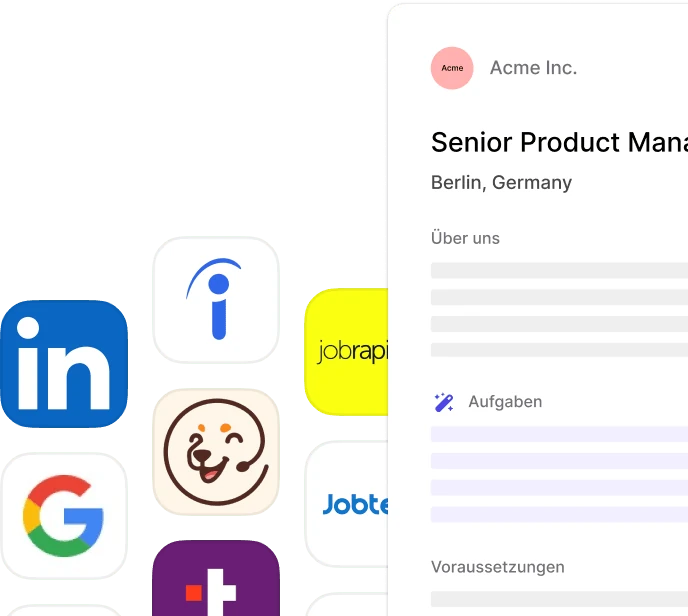Interview and hiring scorecards: Benefits and templates
Deciding which candidate to hire can be challenging, especially in the early interview stages. How do you decide which candidate is best for the job? Or compare between candidates’ answers? Well, your solution might be an interview scorecard! With our hiring scorecard template, your interview process could not be easier. Read on to find out how!
Table of contents
Whether you need to decide between candidates or evaluate a candidate’s interview, a hiring scorecard (sometimes called recruiting scorecard) is a perfect tool to keep track of and measure different key performance indicators (KPIs) of your hiring process.
We’ve created an easy-to-use hiring scorecard template (download above) to facilitate your interviews and choose the right candidate efficiently. Or, if you want more flexibility and tailor your scorecard to specific roles you’re interviewing for, you can use JOIN (completely for free!) to create your own custom scorecards.
Inside our free recruiting software, you can build custom interview scorecard templates based on your specific needs and preferences. For example, you can create a different template for each different type of interview in your process (like the cultural fit interview). Similarly, you can create separate, reusable templates based on the specific role you’re hiring for.
Create your own custom scorecards
Do you want to learn more about hiring scorecards first and how they can benefit your business? Then keep on reading.
We’ll guide you through the wonders of scorecards and show you step-by-step how a hiring scorecard can make your life easier. Here’s what you’ll learn:
- Hiring, interviewing, and scorecards
- Benefits of a scorecard
- What should be on a scorecard
- How to implement a scorecard
Hiring, interviewing, and scorecards
Let’s start from the beginning. So what is a scorecard? A scorecard is a tool that measures and tracks the performance of your business, team, or candidate against a set of predefined goals or targets. For example, you can use it to assess customer sentiment or to keep track of your recruitment KPIs.
A scorecard has many types and uses depending on the industry you are working in. In the case of HR, the two most used scorecards are the hiring/interview-questions scorecard and the HR scorecard.
In the case of HR scorecards, it is used to help manage and improve the strategic role of the HR team. Furthermore, it does not only keep track of HR metrics but helps predict the future growth of your business and plan for better HR results (check out our scorecard glossary to learn more about HR scorecards!).
On the other hand, an interview/hiring scorecard is a tool that helps evaluate a candidate’s qualifications for a position. It ensures that your business considers candidates fairly and consistently and that candidates get rated using an objective measurement tool.
It’s an excellent method to get the best hire out of the talent pool and improve your interview process.
Benefits of scorecards
Using an interview scorecard, HR, recruiters, or hiring managers can assess a candidate’s performance within a concise and structured framework. Below are some benefits hiring scorecards can bring to you and your team:
Improved focus and alignment
Hiring scorecards help organisations focus on key performance areas and align their efforts towards specific goals. Furthermore, it saves time and conflicts when choosing the best candidate.
Due to this increased focus and alignment, your team has more time to focus on improving other parts of the hiring process. You can spend more time crafting the perfect job ad (check out our guide on how to write a good job ad for tips!) or choosing the right pre-screening questions.

Increases fairness while stopping bias and judgment
One key benefit of hiring scorecards is that they provide a clear, structured, and consistent summary of key performance indicators and questions. This makes it easier for managers and teams to understand how you decide on candidates and evaluate them. This increases transparency and accountability.
Recruiting scorecards hold individuals and teams accountable for their decisions. Interviewers cannot make a decision based on the impression of a candidate (which could be biased and difficult to justify).
It encourages the interviewer to assess candidates on effective criteria, and separate each candidate with their different answers. Which leads us to the next benefit.
Allows for structured interviews
Some scorecards are only focused on rating skills and qualities of a candidate, such as communication skills or technical expertise (important when hiring a software engineer, for example). But often, a recruitment scorecard will also include the actual interview questions you want to ask your candidates.
By preparing exactly which questions you want to ask, and then reusing the same card for each candidate interview, you will have much more structured interviews. Not only does this make it easier for you to prepare, but it also means you only have to prepare once, after which you can just reuse the same template.
And by asking every candidate the exact same questions, it becomes much easier to compare different candidates. Which again ties in with our previous benefit of improving fairness.
Better decision-making
Hiring scorecards provide a clear and objective view of what type of employee the company is looking for. Hiring scorecards help you define the requirements for the open job position and assess candidates’ responses more concisely.
It helps you think through your requirements and choose the right few important ones. This ultimately leads to better (and faster) decision-making.
Improved communication
The hiring scorecard takes the guesswork out of figuring out who’s responsible for what candidate or interview and gets the whole team working together. Additionally, this can be used to communicate interview information to various teams and managers.
Well, now that we’ve talked about the wonders hiring scorecards can bring to your business, you’re probably asking yourself:
What should be on an interview scorecard?
As mentioned before, a scorecard is a perfect tool to track and measure the effectiveness of your interview process and facilitate choosing the perfect candidate. To improve the hiring process, you can use an interview scorecard and choose your top candidates efficiently.
But what information do you put on an interview or recruiting scorecard?
The goal of an interview scoresheet is to easily compare candidates’ qualifications and suitability for the job under the same criteria. So think of what attributes and questions will help you reach that goal.
Usually, an interview scoring sheet includes the following:
- A rating system (most commonly 1-to-5 or 1-to-10)
- Interview questions that evaluate a candidate’s skills, traits, qualifications, and experience
- Defined criteria specific to the open position
- (Unbiased) standards for the cultural fit of the candidate
- A comments or notes section
- A “total score” section
The interview scorecard should make your hiring process more consistent and objective. For this reason, your interview scorecard template should be structured with a uniform rating and scoring system.
So now, we need to figure out how to create and implement a hiring scorecard.
How to implement a hiring scorecard
When you know your goals, implementing and creating a hiring scorecard is relatively easy. Below, we outline 4 simple steps on how to make your perfect hiring scorecard:
1. Prepare a structured interview with good questions
The questions and scoring system are the most critical aspects of the hiring scorecard. The easiest way to start creating your scorecards and have the best interview questions is by having an effective structured interview plan.
Think of the right soft skills interview questions, but also collect hard skills interview questions essential in your industry or the specific role you’re recruiting for. Also be sure to throw some situational interview questions and behavioural interview questions in there.
Consider all your questions and choose the most relevant ones. Remember, it’s good to come up with many questions, but make sure to order and prioritise them based on importance so they’ll fit the timeframe of your interview.
2. Add extra scoring categories
An interview isn’t complete without a firm handshake (unless it’s an online interview), eye contact, good preparation, and a professional presentation. But a hiring manager’s intuition usually dictates how significant an impact these details have.
To make things fair and appreciate the candidate’s efforts, you should consider creating other scoring categories besides questions. This time, you’d score potential hires based on their answers and how they carried themselves during the interview.
3. Have a defined scoring system
Deciding on a numerical score is quite tricky! Since it may differ from person to person. Some people may think ⅗ to be a decent score or average, while others may think it’s mediocre and almost a failure. For this reason, It’s essential to define each possible score so interviews (and scoring) are consistent.
A scoring system with a big scale (e.g. 1 to 10) might make giving distinct meaning to each possible score challenging. So, a score with a range of 1-5 or 1-4 is often preferred.
We suggest you describe the values in a 1-5 scoring system like the one below:
- A wrong answer that missed the crucial points of the question altogether.
- An incomplete answer with some good elements, but most of the answer was flawed.
- An average answer with some level of understanding of the question. But falls short because of problems with the content of the answer or/and skills.
- A great answer with a deep understanding of the question, but still missing some competencies or skills.
- A perfect answer with a great understanding of the question and a high competence level.
4. Choose an accessible format for your hiring scorecard
This step depends a lot on personal preference.
If you like to keep it digital and more easily customisable, you can build your own hiring scorecard templates with JOIN in just a few minutes. It’s one of the many free features inside our talent attraction software, alongside one-click multiposting of job ads to 15+ free job boards (and discounts to another 250+ premium ones).
Of course, some people prefer to stick with a good-old piece of paper where they can write comments and ratings with a pen.
In that case, you’ll need to design an easy-to-use format to print out in your office. You can do this yourself in a Word or Google Doc, or use a dedicated design tool of your choice.
Belen Robleto
Belen was JOIN's Marketing Intern. She helped the team by writing diverse HR content and maintaining our social media channels.


